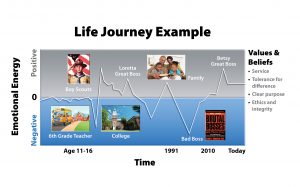Values and beliefs shape how people lead. My best bosses have understood their personal values and beliefs, and then used that insight to focus their efforts and lead their teams effectively.
A key tenet of Emotional Intelligence says that self-awareness is critical if a person is to manage their emotions, understand how others might react, or use interpersonal knowledge and skills to interact with others effectively.
But that insight develops over the course of a lifetime. So how does a trainer help participants to develop the necessary insight quickly, in a way that enables them to take action when they return to the job?
One of the most effective experiential methodologies is the Life Journey exercise. Noel Tichy, in the “Cycle of Leadership,” and Laura Freebairn-Smith, who adapted it from the work of Linkage, Inc., outline the approach. The activity guides people to review their critical life events to help them clarify their values and beliefs, and then uses those insights to enable them to articulate their motivation and rationale on leadership—what Tichy terms “their teachable point of view.”
LIFE JOURNEY EXERCISE STEPS

- Explain the purpose of the exercise. This will help develop insight into the core values and beliefs that shape a person’s focus and leadership behavior.
- Set up the basic diagram. This can be done on a flip chart, piece of paper, or electronically. Each person will create a graph (see the Life Journey Example illustration) with emotions on the “Y” axis, ranging from negative (terrible experience) to positive (peak experience). The “X” axis shows time, ranging from birth to current day.
- Ask participants to depict their life path by using words, symbols, or pictures that illustrate their work, personal experiences of pain or joy, and significant formative relationships. Participants place them in the appropriate points on the timeline. A line can be used to “graph” the emotional energy of each event.
- Ask participants to reflect on the chosen events and situations, and make adjustments as needed. Remind them that no diagram can possibly capture everything that shapes a life journey.
- Ask participants to choose two or three formative events and use them to identify their core values and beliefs. They then write their insights next to the diagram.
- Ask participants to review their insights with a partner and describe how at least one value or belief was operationalized in their work and life.
The Life Journey exercise enables individuals to articulate their values and beliefs, tell the story of how their life experience shaped their perspective, and use those insights to become more effective leaders.


